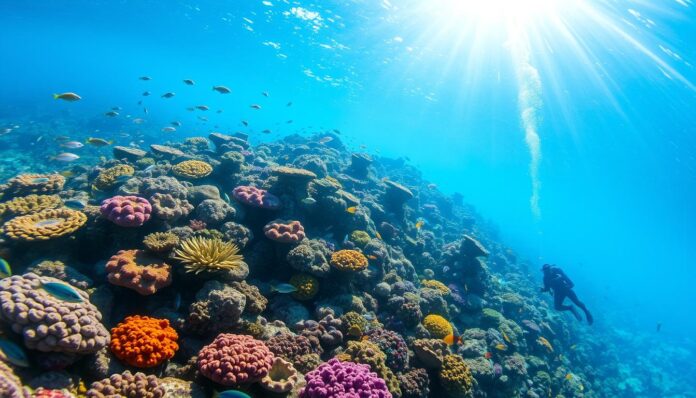| Best Time to Travel | Year-round, but best from March to November |
| What to Expect | Warm water, clear visibility, diverse marine life |
| Diving Conditions | Year-round, but best from March to November |
| Marine Life | Sea turtles, sharks, rays, fish, corals |
Are you ready to explore Bonaire’s underwater paradise? Imagine diving into crystal-clear waters. Here, vibrant marine life thrives and pristine coral reefs stretch as far as the eye can see.
Scuba diving in Bonaire is more than an adventure. It’s a journey into one of the Caribbean’s most spectacular marine ecosystems. With over 70 designated dive sites and depths from 15 to 130 feet, this small island offers an unparalleled underwater experience for divers of all skill levels.
Bonaire isn’t just another diving destination. It’s a marine wonderland where divers can explore extraordinary sites like Bari Reef, home to 361 fish species. The island’s commitment to marine conservation has earned it the nickname “Divers Paradise” – a title proudly displayed on every local license plate.
Key Takeaways – Scuba Diving in Bonaire
- Explore over 70 world-class dive sites in Bonaire
- Enjoy consistent water temperatures between 78-82°F
- Experience exceptional visibility of 60 feet or more
- Discover diverse marine ecosystems with 361 fish species
- Dive in depths ranging from 15 to 130 feet
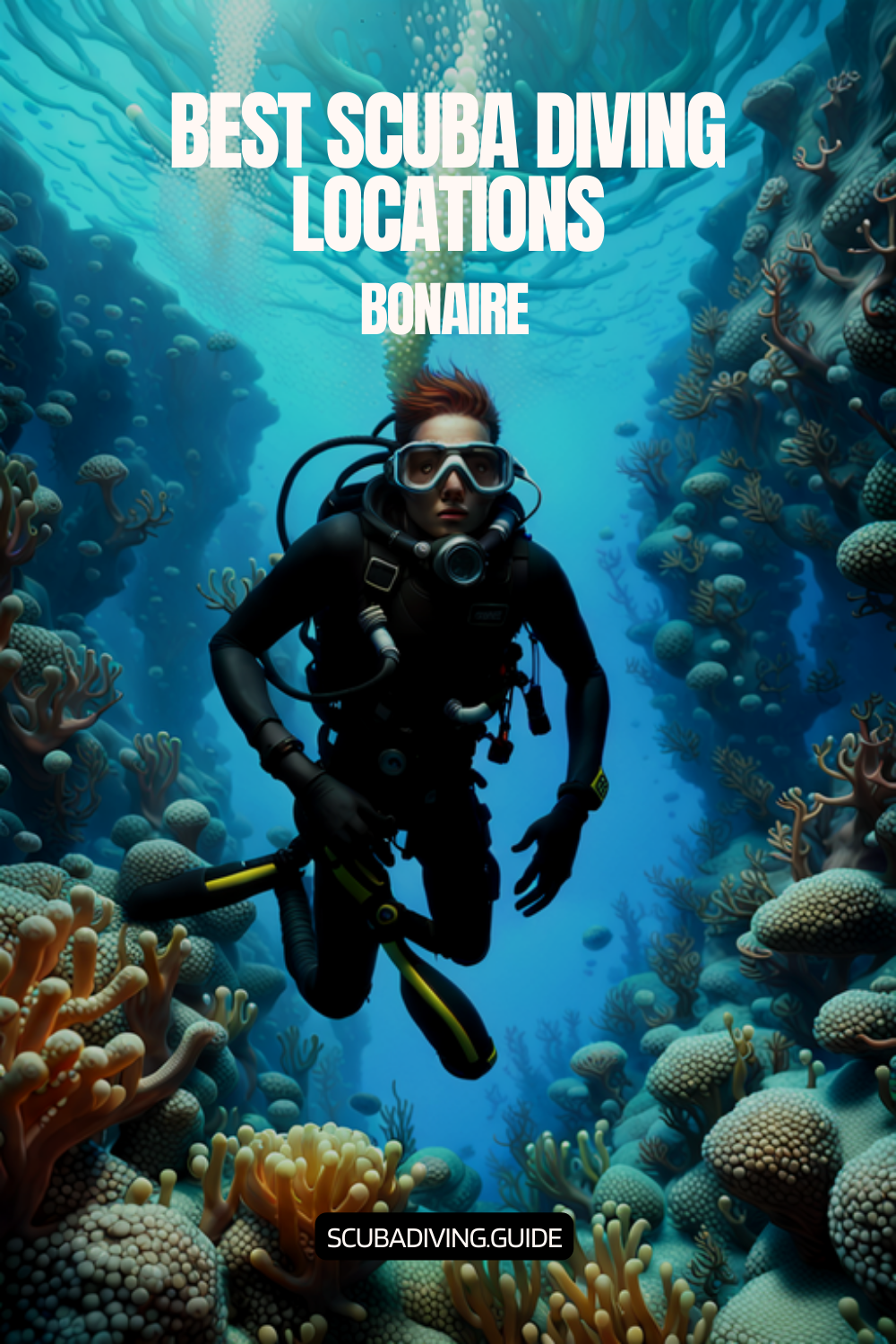
Why Choose Bonaire for Scuba Diving?
Bonaire is a top spot for scuba diving, attracting divers worldwide. Its unique marine life and great diving spots make it perfect for all levels. Whether you’re new or experienced, Bonaire has something for everyone.
Unique Marine Ecosystem
Bonaire’s coral reefs are a true underwater paradise. They are home to a wide variety of marine life. You can see many species, including:
- Multiple eels
- Drumfish
- Puffers
- Giant groupers
- Sea turtles
Year-Round Diving Conditions
The diving conditions in Bonaire are amazing all year. The water is warm, between 78 to 82 degrees Fahrenheit. You can see up to 60 feet underwater, making every dive clear and exciting.
| Diving Condition | Specification |
|---|---|
| Water Temperature | 78-82°F |
| Average Visibility | 60+ feet |
| Shore Dive Sites | 60+ marked locations |
| Recommended Wetsuit | 3mm |
Accessibility and Convenience
Diving in Bonaire is super easy and convenient. It has been voted the best shore diving spot for 27 years. With over 60 marked sites, you can dive right from the beach.
“Bonaire is not just a diving destination, it’s an underwater paradise waiting to be explored.” – Diving Enthuasiast Magazine
Bonaire is great for all divers, from beginners to experts. Its amazing marine life, consistent conditions, and easy access make it a top choice for underwater adventures.
The Best Dive Sites in Bonaire
Bonaire diving sites are a paradise for scuba lovers. The island has some of the most amazing marine environments in the Caribbean. Each dive site has its own special underwater landscapes and vibrant marine life.
Divers can see a wide range of underwater terrains. From dramatic wall dives to artificial structures full of marine life. Here are the top dive sites in Bonaire:
Blue Hole
This dive site is known for its stunning underwater topography. Divers will see:
- Unique rock formations
- Diverse marine ecosystems
- Exceptional visibility
1000 Steps
This site is famous for its dramatic entry. It’s a challenging dive but offers a rich marine biodiversity.
Salt Pier
Salt Pier is an artificial structure turned marine sanctuary. It provides:
- Multiple pilings covered in marine growth
- Abundant fish populations
- Unique underwater photography opportunities
Klein Bonaire
Klein Bonaire is an uninhabited island off Bonaire’s west coast. It has pristine dive sites like Ebo’s Special. Highlights include:
- Untouched coral reefs
- Diverse marine life
- Crystal-clear waters
“Diving in Bonaire is like entering a living, breathing underwater museum of marine biodiversity.” – Local Dive Instructor
| Dive Site | Key Features | Difficulty Level |
|---|---|---|
| Blue Hole | Unique rock formations | Intermediate |
| 1000 Steps | Dramatic entry, rich marine life | Moderate |
| Salt Pier | Artificial structure, marine sanctuary | Easy |
| Klein Bonaire | Pristine reefs, clear waters | All Levels |
Each dive site in Bonaire offers a unique look into the underwater world. They promise unforgettable experiences for divers of all levels.
Dive Operators and Schools
Bonaire is known for its top-notch diving spots. It has excellent dive operators and schools for all levels. Whether you’re new or experienced, you’ll find great places to dive.
Recommended Dive Shops
Bonaire Dive Resorts offer amazing diving experiences. Here are some of the best places to dive:
- Buddy Dive Academy – A PADI 5-Star Career Development Center
- Scuba Do – PADI 5-Star Dive Resort
- Drive-through tank-filling stations for convenient diving
Certifications and Training Offered
Bonaire has certifications for all skill levels:
- Beginner Courses:
- Discover Scuba Diving ($90)
- PADI Scuba Diver
- PADI Junior Open Water Diver
- PADI Open Water Diver ($485)
- Advanced Courses:
- PADI Advanced Open Water ($325)
- Peak Performance Buoyancy
- Deep Diver Specialty ($275)
- Night Diver Course ($225)
Guided vs. Independent Diving
Divers can choose between guided and independent dives. Guided dives offer expert guidance and insights. Independent dives give you freedom. Unlimited shore diving packages make Bonaire special for diving.
“Bonaire transforms diving from an activity into an unforgettable adventure” – Local Dive Instructor
Whether you’re new or experienced, Bonaire’s dive operators ensure safe, memorable dives. They offer professional training and top facilities.
Equipment Rental and Sales
Getting ready for Scuba Diving in Bonaire means thinking about your gear. The island is known as a “Diver’s Paradise.” You’ll find great places to rent or buy equipment for your dive.
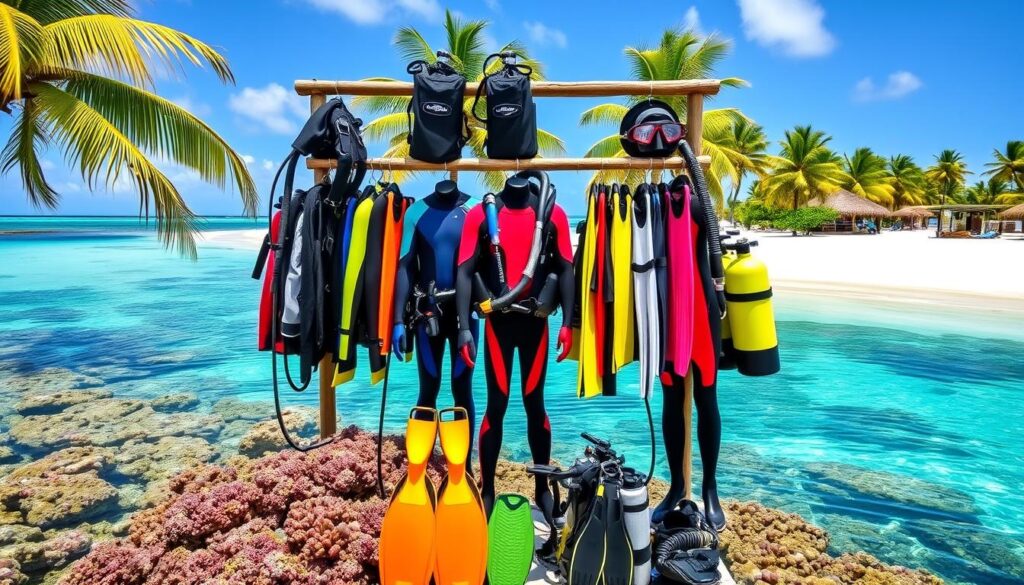
Where to Rent Gear in Bonaire
There are many good places to rent diving gear in Bonaire:
- Technical Diving Services (TDS): A 5-star SDI/TDI dive center with full rental services
- Buddy Dive Tek: Offers a wide range of rental gear, including technical diving equipment
- Captain Don’s Habitat: Provides all the gear you need with unlimited air
Buying vs. Renting: What to Consider
Choosing between buying or renting diving gear depends on a few things:
- Trip Duration: For short trips, renting might be better
- Diving Frequency: If you dive a lot, buying your own gear could be smarter
- Equipment Specialization: For technical diving, you might need to buy specific gear
“Bonaire’s diving conditions usually don’t need much thermal protection. A 3 mm suit or even a swimsuit and rash guard are often enough for comfortable diving.” – Local Diving Expert
For Scuba Diving in Bonaire, think about renting special gear like Diver Propulsion Vehicles (DPVs) from Technical Diving Services. These are only for certified divers. Dive centers on the island offer unique ways to make your dive better.
Additional Rental Considerations
Some dive centers offer more than just basic rentals:
- Digital photo equipment rentals
- Gas blending stations for technical divers
- Underwater photography gear
Whether you rent or buy, Bonaire’s diving setup ensures you’ll have the best gear for an amazing dive.
Best Times to Dive in Bonaire
Bonaire is a tropical paradise for diving enthusiasts. It offers amazing underwater experiences all year. The island’s location south of the Caribbean hurricane belt makes it perfect for scuba diving.
Seasonal Diving Highlights
The best time to dive in Bonaire is from April to November. This period has the best conditions for exploring the underwater world.
- Best diving months: May and June
- Lowest crowd periods: September and October
- Warmest water temperatures: August and September (80-86°F)
Weather Considerations
Bonaire’s diving conditions are always good, with little weather trouble. The island has:
- Average air temperatures: 78-87°F
- Annual precipitation: Just 25 inches
- Rarely canceled diving days
“Bonaire provides divers with near-perfect conditions year-round, making it a top destination for underwater enthusiasts.”
Wildlife Interaction Opportunities
For diving fans, Bonaire is a dream come true. It offers amazing chances to see marine life. Highlights include:
- Annual coral spawning in September and October
- Visibility ranging from 40 to 100 feet
- Over 60 diverse dive sites
Pro tip: September and October are great for seeing coral spawning and avoiding crowds.
Marine Conservation Initiatives
Bonaire is a world leader in marine conservation. It has turned its underwater world into a model for protecting the environment. The island’s efforts to save its marine life are truly unique.
The Bonaire National Marine Park is a key part of this effort. It was set up in 1979 to protect the entire coastline of Bonaire and Klein Bonaire. This park ensures that all marine life in these areas is safe.
Importance of Conservation Efforts
Bonaire’s work in marine conservation is recognized worldwide. In 2001, it was named the first runner-up for sustainable tourism. This shows how its marine protection policies are innovative.
- Protects over 60 dive site markers
- Maintains 100+ public mooring sites
- Nominated for United Nations World Heritage status in 2004
Dive Against Debris Programs
PADI’s Dive Against Debris is a big part of Bonaire’s conservation plan. Divers help clean the ocean, making a big difference.
| Debris Composition | Percentage |
|---|---|
| Plastic Items | 70% |
| Other Materials | 30% |
Coral Restoration Projects
Bonaire is working hard to restore its coral reefs. These projects aim to rebuild and protect marine habitats. Coral reefs are vital, supporting nearly 25% of marine life despite covering only 1% of the ocean.
“Our oceans are the lungs of our planet, and every dive is an opportunity to protect them.” – Local Marine Conservationist
Divers can join in on many conservation efforts. They can help manage coral nurseries, clean beaches, and learn about sustainable marine interactions through educational programs.
Underwater Photography Tips
Bonaire underwater photography lets you capture the amazing marine life of this Caribbean paradise. With over 350 fish species and 60 coral types, it’s a perfect place for underwater photos.
To get great shots of Bonaire’s marine life, you need special skills and gear. Pros say it’s key to know the underwater world before you start taking pictures.
Best Practices for Marine Photography
- Use natural light whenever possible
- Approach marine subjects slowly and calmly
- Maintain a respectful distance from wildlife
- Practice buoyancy control for steady shots
Recommended Photography Gear
| Camera Type | Recommended Lens | Best For |
|---|---|---|
| Compact Camera | Wide-angle | Beginner photographers |
| DSLR | 100/105mm macro | Detailed marine life shots |
| Mirrorless | 60mm range | Larger fish portraits |
Pro tip: The ideal photography depth in Bonaire ranges from 30 to 90 feet, with visibility averaging 60 to 100 feet.
“Patience is the key to extraordinary underwater photography in Bonaire’s marine sanctuary.” – Marine Photography Expert
For underwater photography in Bonaire, look for macro subjects like scorpionfish and blennies. Wide-angle shots are great for tarpon, barracuda, and sea turtles against the island’s beautiful coral.
Planning Your Dive Trip
Getting ready for an amazing dive trip in Bonaire needs careful planning. The island is perfect for divers looking for top-notch underwater adventures. This guide will help you pick the best Bonaire Dive Resorts and figure out how to get around.
Choosing the Right Accommodations
Finding the right place to stay is key for your dive trip. Bonaire Dive Resorts have special features for divers. Think about:
- How close it is to dive spots
- Where to store your gear
- If there’s a dive center on site
- Options for unlimited shore diving
Transportation Strategies
Getting around Bonaire needs smart planning. Most dive packages come with car rentals. This is important for visiting different shore diving spots.
| Transportation Option | Pros | Recommended For |
|---|---|---|
| Rental Vehicle | Maximum flexibility | Independent divers |
| Resort Shuttle | Convenient, no driving stress | First-time visitors |
| Taxi Services | Short-distance travel | Limited site visits |
Flight and Arrival Considerations
Bonaire’s main airport gets most international flights on Saturdays. Pro tip: Choose Bonaire Diving Packages with flexible arrival dates to dive more.
“Planning is the key to an extraordinary diving experience in Bonaire” – Local Dive Instructor
With good planning, your Bonaire diving trip will be smooth and unforgettable. Do your research, book early, and get set to dive in one of the world’s best spots.
Safety Considerations for Divers
Scuba diving in Bonaire is an amazing experience, but safety comes first. The island’s marine environment is unique. Divers need to be ready and know the risks and precautions.
Getting a Bonaire Dive Certification is key for a safe dive. Divers must know the special safety rules of this place.
Essential Safety Gear
Every diver in Bonaire needs these important safety items:
- Surface Marker Buoy (mandatory for all dives)
- Dive computer
- Reef-safe sunscreen
- Dive boots (required for most dive sites)
- First aid kit
Avoiding Common Diving Risks
To dive safely in Bonaire, follow these important tips:
- Complete a mandatory orientation dive upon arrival
- Practice excellent buoyancy control
- Never dive alone
- Stay within your certification level
- Respect marine life and park regulations
| Safety Consideration | Details |
|---|---|
| Marine Park Fee | $165 annual access |
| Maximum Dive Depth | 60 meters |
| Water Temperature | 27°C (80°F) |
| Dive Site Restrictions | 88 marked sites, 2 marine reserves off-limits |
“Safety in diving is not just about equipment, but about knowledge, respect, and preparation.”
The east coast of Bonaire is best for advanced divers with guides. Always put your safety and the marine ecosystem first during your dive in Bonaire.
Post-Dive Activities in Bonaire
After diving into Bonaire’s underwater world, there’s much more to see and do. The island is a mix of marine adventures and cultural experiences. This keeps visitors busy and engaged during their stay.
Snorkeling Adventures Beyond Diving
For those who prefer lighter water activities, Bonaire Snorkeling is perfect. Lac Bay is a top spot for snorkeling. It offers:
- Extensive mangrove ecosystems
- Opportunities to spot sea turtles
- Habitat of the endangered queen conch
Exploring Local Culture and Cuisine
Scuba Diving in Bonaire isn’t just about the sea. The island’s culture and food are also worth exploring. Visitors can enjoy:
- Traditional Caribbean restaurants
- Local music and dance performances
- Artisan markets showing off regional crafts
“Bonaire is more than just a diving destination – it’s a complete tropical experience!” – Local Tourism Board
With meals from $10-$30 and drinks $5-$15, trying local food is affordable. The island’s friendly people make every moment off the water unforgettable.
Travel Tips for Visiting Bonaire
Planning your Scuba Diving in Bonaire adventure needs careful preparation. This guide will help you with essential travel information. It ensures a smooth and enjoyable experience with Bonaire Diving Packages.
Visa and Entry Requirements
Most travelers have good news! About 90% of the world’s citizens, including U.S. and Canadian passport holders, can enter Bonaire without a visa for up to 90 days. Here are some key entry details:
- Tourist tax: $75 for visitors 13 and older
- Children 12 and under: $10 per visit
- Departure tax: $35 (usually included in airline ticket)
Currency and Payment Methods
The U.S. dollar is Bonaire’s official currency. This makes money matters easy for American travelers. Most places accept major credit cards. But, it’s smart to carry some cash for small vendors.
| Payment Type | Acceptance |
|---|---|
| U.S. Dollars | Widely Accepted |
| Credit Cards | Accepted at Most Locations |
| Tipping | 10-15% Recommended |
Practical Travel Information
Before your Scuba Diving in Bonaire trip, consider these important details:
- Electric current: 127 volts, 50 hertz
- Emergency phone number: 911
- Time zone: Atlantic Standard Time
- Driving requirements: Valid international driving license
“Preparation is the key to an unforgettable diving adventure in Bonaire!” – Local Diving Expert
With these travel tips, you’re set to explore Bonaire’s stunning underwater world. Enjoy a hassle-free vacation experience.
Diving Etiquette and Best Practices
Diving in Bonaire is a big responsibility. The Bonaire National Marine Park has been well-kept for 35 years. It’s a pristine underwater world that needs respect and careful interaction from all divers.
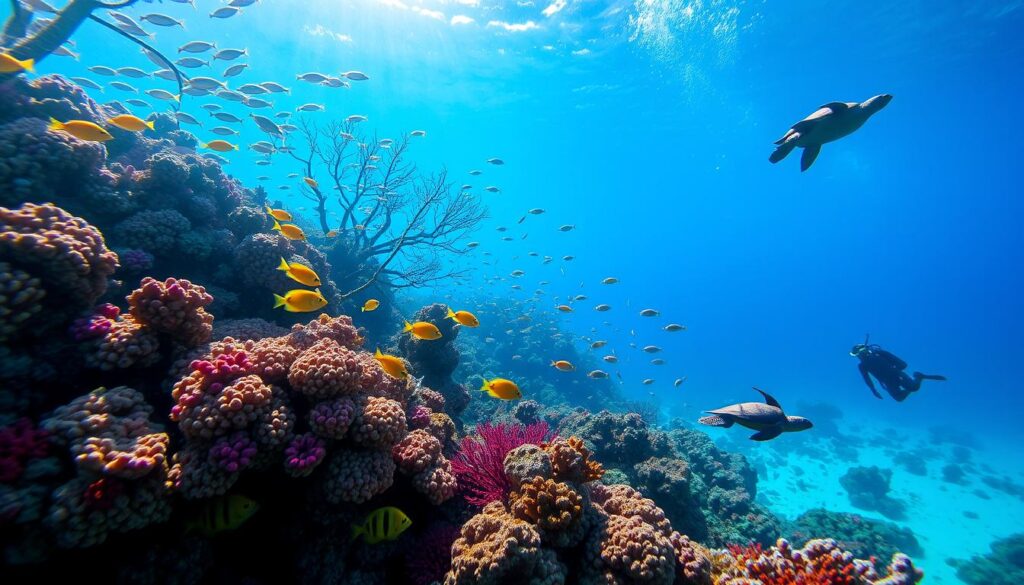
Protecting the Bonaire Coral Reefs is key. It requires following specific guidelines to keep the marine ecosystem safe.
Respecting Marine Life
Divers must follow important rules when exploring Bonaire Marine Life:
- Maintain neutral buoyancy to prevent accidental coral damage
- Never touch or disturb marine creatures
- Avoid chasing or harassing underwater wildlife
- Use reef-safe sunscreen to protect marine ecosystems
Diver Guidelines
The Bonaire Marine Park has specific rules for diving:
- Purchase a mandatory Marine Park Tag ($40.00 valid for one calendar year)
- Attend a mandatory diver orientation for first-time visitors
- Complete a check-out dive to verify equipment and buoyancy skills
- Respect underwater photography restrictions
“Dive with care, leave only bubbles, take only memories.”
| Diving Practice | Recommended Action |
|---|---|
| Buoyancy Control | Perfect neutral positioning to protect coral structures |
| Marine Interaction | Observe but never touch marine creatures |
| Equipment Usage | Use recommended reef-safe gear and techniques |
Remember, every diver plays a key role in keeping Bonaire’s underwater world safe.
Frequently Asked Questions about Diving in Bonaire
Diving in Bonaire is exciting for many. It’s great for both experienced scuba divers and those just starting out. Knowing the basics of diving in Bonaire will make your underwater adventure unforgettable.
What to Expect as a Beginner
Bonaire Dive Certification makes diving easy for beginners. The island has over 80 dive sites with super clear waters. You can see up to 100 feet underwater. Beginners have many advantages:
- Calm, crystal-clear waters with temperatures ranging from 78°F to 84°F
- Numerous dive shops offer entry-level certification courses
- Shallow shore diving locations are perfect for newbies
“Bonaire is like an underwater paradise for divers of all skill levels” – Local Dive Instructor
Dive Insurance: Is It Necessary?
When you plan your Scuba Diving in Bonaire, getting dive insurance is a good idea. It’s not required but it’s very important for safety.
| Insurance Coverage | Recommended Benefits |
|---|---|
| Medical Evacuation | Covers emergency transportation |
| Diving Equipment | Protects against loss or damage |
| Trip Cancellation | Reimburses non-refundable expenses |
Pro tip: Check with your current travel insurance provider about diving coverage before buying a separate policy.
Bonaire Recommended Scuba Diving Itinerary
When planning your scuba diving trip to Bonaire, it’s essential to create an itinerary that allows you to experience the best dive sites and make the most of your time on the island. With over 80 official dive sites to choose from, Bonaire offers a wide range of underwater adventures. Here’s a recommended scuba diving itinerary that will take you on a journey to some of the most captivating dive sites in Bonaire.
Day 1: Arrival and Orientation
Upon arriving in Bonaire, settle into your accommodation and take some time to familiarize yourself with the diving center or resort you’ll be diving with. Attend an orientation session where you’ll receive information about the local dive sites, diving protocols, and any specific guidelines to ensure a safe and enjoyable experience. This orientation will also provide an opportunity to meet your dive guide and fellow divers.
Day 2: Warm-Up Dive and Shore Diving
Start your diving adventure with a warm-up dive at a nearby shore dive site. This allows you to acclimate to the water, check your gear, and ensure your buoyancy control is dialed in. The dive center can recommend an appropriate site based on your experience level.
In the afternoon, venture out for a shore dive. Bonaire is renowned for its accessible shore diving, where you can simply walk into the water and explore the vibrant reefs at your own pace. Some popular shore dive sites include Something Special, Bari Reef, or 1000 Steps, which offer stunning coral formations and abundant marine life.
Day 3: Boat Dive and Wreck Exploration
Embark on a boat dive to explore some of Bonaire’s iconic dive sites. Visit the Hilma Hooker wreck, a sunken cargo ship teeming with marine life and fascinating artifacts. Dive into the depths to explore the wreck’s structure and discover hidden nooks and crannies that provide shelter for a variety of fish species.
In the afternoon, choose another boat dive that takes you to a different part of the island. Consider sites like Karpata or Salt Pier, known for their breathtaking underwater landscapes and diverse marine ecosystems. These sites offer the chance to encounter large schools of fish, colorful coral formations, and intriguing underwater structures.
Day 4: Marine Park Exploration and Night Dive
Explore the Bonaire National Marine Park, a protected area that spans the entire coastline of the island. Dive sites within the marine park offer some of the most pristine and untouched underwater environments. Spend the day exploring sites such as Red Slave or Carl’s Hill Annex, where you can witness the vibrant coral reefs and encounter a variety of marine life, including turtles, eagle rays, and colorful reef fish.
As the sun sets, prepare for a night dive—a truly magical experience. Night dives in Bonaire reveal a different side of the underwater world, with nocturnal creatures emerging from their hiding places. Witness the mesmerizing dance of bioluminescent organisms and encounter fascinating creatures such as octopuses, lobsters, and moray eels.
Day 5: Specialty Dives and Macro Exploration
Dedicate this day to specialty dives and macro exploration. Bonaire is a haven for macro enthusiasts, offering an abundance of unique critters and hidden treasures. Dive sites like Angel City and Invisibles provide an opportunity to search for seahorses, frogfish, and other elusive macro species. Fine-tune your underwater photography skills and capture the intricate details of these fascinating creatures.
Day 6: Double-Dive Excursion and Relaxation
Take a double-dive excursion to fully immerse yourself in the underwater wonders of Bonaire. Choose two dive sites that you haven’t explored yet, perhaps sites like Sweet Dreams or Alice in Wonderland. These sites are known for their stunning coral formations, vibrant marine life, and excellent visibility. After the dives, take time to relax, soak up the sun, and reflect on the incredible experiences you’ve had throughout your diving journey.
Day 7: Departure and Fond Farewells
On your last day, bid farewell to the beautiful island of Bonaire. Take some time to reflect on your scuba diving adventures and the memories you’ve created underwater. Return your rental equipment, say goodbye to your dive guide and fellow divers, and depart with a sense of fulfillment and the desire to return for more diving adventures in the future.
Remember, this itinerary is just a suggestion, and there are countless other dive sites to explore in Bonaire. Customize your itinerary based on your preferences, skill level, and the recommendations of your dive center or resort. Bonaire’s underwater realm awaits, promising unforgettable experiences and a world of marine wonders to discover.
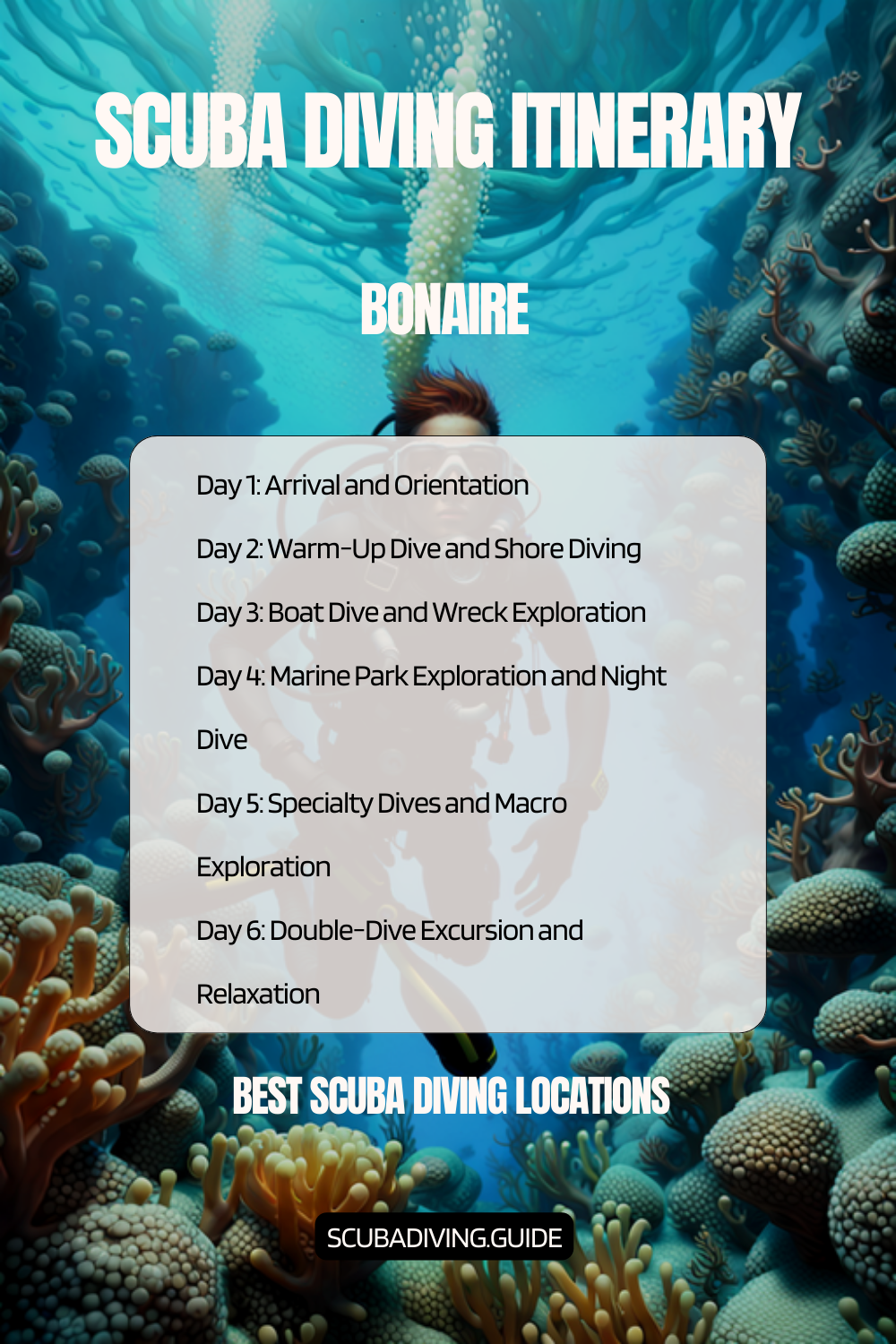
Other Countries to Consider
- Anguilla
- Antigua and Barbuda
- Aruba
- Bahamas
- Barbados
- British Virgin Islands
- Cayman Islands
- Cuba
- Curaçao
- Dominica
- Dominican Republic
- Grenada
- Guadeloupe Islands
- Haiti
- Jamaica
- Martinique
- Montserrat
- Puerto Rico
- Saba
- Saint Barthélemy
- Saint Kitts & Nevis
- Saint Lucia
- Saint Vincent and the Grenadines
- Sint Eustatius
- Sint Maarten
- The Turks And Caicos Islands
- Trinidad and Tobago
- United States Virgin Islands
Conclusion: Dive into the Adventure!
Scuba diving in Bonaire is an amazing underwater adventure. It attracts divers from all over the world. With almost 85 dive sites, three-quarters are right off the shore.
This Caribbean paradise is perfect for exploring the sea. The “Shore Diving Capital of the World” has warm waters and beautiful marine life.
Creating Lasting Memories
Your dive in Bonaire will be unforgettable. You’ll see colorful dive sites and meet many sea creatures. Each dive is a new adventure.
The island has great diving spots and many dive schools. This makes diving fun and easy for everyone, whether you’re new or experienced.
Encouragement to Explore and Protect the Ocean
When you dive, remember to dive responsibly. Learn about marine conservation and respect the sea. Bonaire is dedicated to protecting its oceans.
Get ready for an underwater adventure. Every dive is a new story and every moment is a memory. Your Scuba diving in Bonaire journey is waiting. Dive in and discover the magic!
FAQ – Scuba Diving in Bonaire
Do I need prior diving experience to dive in Bonaire?
Bonaire welcomes divers of all levels. Beginners can start with certification courses at local dive shops. Experienced divers can dive on their own.
Many resorts offer training for new divers. They also provide guided tours for those just starting out.
What is the best time of year to dive in Bonaire?
Bonaire’s diving is great all year, with water between 78-84°F (26-29°C). It’s safe from hurricanes, making it a reliable spot. The best diving is from April to November, with clear waters and calm seas.
Are shore dives really as good as boat dives in Bonaire?
Yes! Bonaire’s shore diving is amazing. You can dive right from the beach at places like Salt Pier and 1000 Steps. This means no need for a boat.
What marine life can I expect to see while diving?
Bonaire’s underwater world is full of life. You might see sea turtles, parrotfish, and even dolphins. The coral reefs are home to many species, making each dive unique.
Do I need to bring my own diving equipment?
You can bring your own gear, but Bonaire has great rental options. Many dive packages include rental, making it easy. But, it’s smart to bring your mask and dive computer.
Is dive insurance necessary in Bonaire?
Yes, dive insurance is a must. Many dive shops require proof of insurance for diving emergencies. DAN offers plans that cover diving-related medical issues.
How can I contribute to marine conservation in Bonaire?
Bonaire has many ways to help marine conservation. You can join coral restoration projects or dive against debris. Divers can also volunteer, dive responsibly, and support local marine parks.
What certification levels are available in Bonaire?
Bonaire offers diving certifications from beginner to advanced. PADI-certified centers provide courses from Open Water Diver to Dive Master. They also offer specialty courses like underwater photography.
Are there any specific diving regulations I should know about?
The Bonaire National Marine Park has rules to protect its marine life. You must not touch marine life or collect souvenirs. Always dive carefully to avoid damaging coral. Follow local guidelines and respect the sea.
What underwater photography tips can you recommend for Bonaire?
Bonaire is great for underwater photos. Use a camera that works well in low light. Bring wide-angle lenses for reef shots and macro lenses for small creatures. Klein Bonaire and Salt Pier are perfect for photos.
